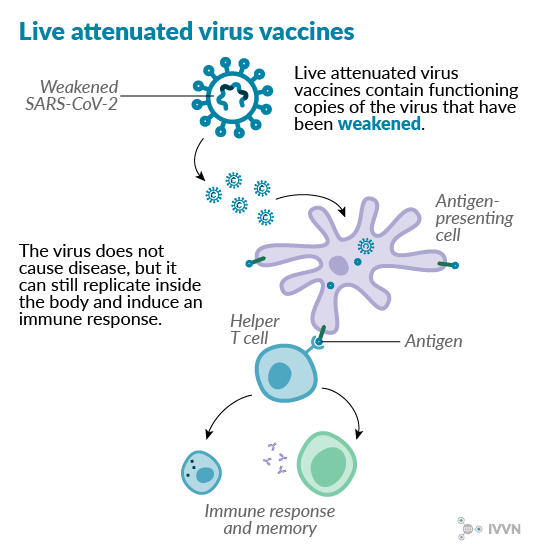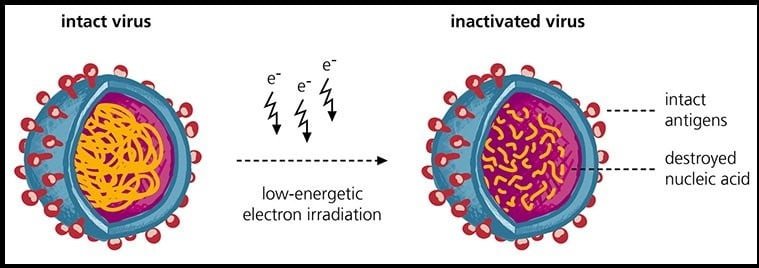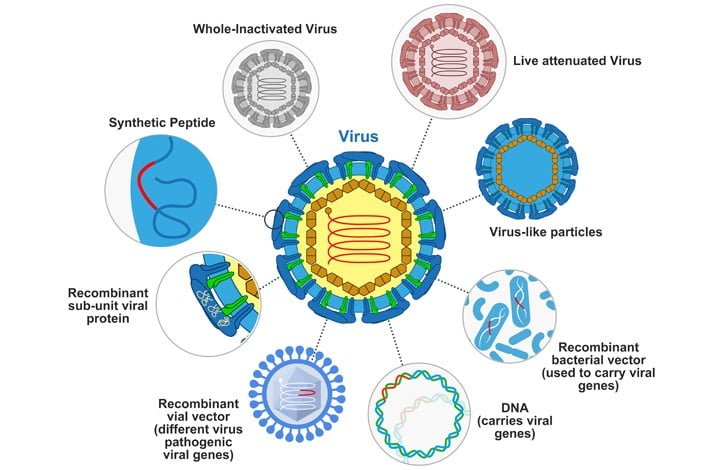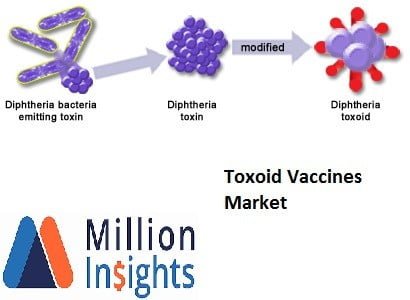Vaccination is the subjection of live or killed microorganism (vaccines) in order to boost immune system to develop protection against bacterial or viral diseases.
Principle of vaccination:
In order to understand how vaccine work towards our body, we need to have a basic understanding about the human immune system and how does it response towards the vaccine. Human immune system is the ability of identifying and defensing a foreign bodies and eliminating them with our bodys own healthy cells.
Immune system then develops a response against antigens and this defensive response is known as immune response. During immune response, usually protein molecules such as antibodies or immunoglobulins and cell mediated cells are involved.
For an immunity to response, it goes under two basic mechanisms:
- Active immunity
- Passive immunity
Active immunity is acquired from the bodys own immune system whereas passive immunity can be acquired from the transfer of animal or human antibody produced by it.
Active immunity develops memory cells and is known as immunologic memory that lasts for a lifetime in human body but passive immunity is temporary and can be lost during life activities. It can be acquired from mother to an infant during birth and from transfusion of immunoglobulins and plasma products.
Some common vaccination against viral infections are:
- Hepatitis A vaccine
- Hepatitis B vaccine
- Chickenpox vaccine
- Influenza vaccine
- Polio vaccine
- Diphtheria, tetanus and whooping cough vaccine (DtaP)
- Measles, mumps and rubella vaccine(MMR)
- Pneumococcal polysaccharide vaccine
- Pneumococcal conjugate vaccine
- Rabies vaccine
- Rota virus
- Yellow fever
- Shingles virus
- Tdap virus
Four main types of vaccination and how it works against several viral diseases:
- Live-attenuated vaccine
- Inactivated/killed vaccine
- Sub-unit, recombinant, polysaccharide and conjugate vaccine
- Toxoid vaccine
1. Live attenuated vaccine:
- In live attenuated vaccine, living microorganisms are injected into the body. These live microorganisms are attenuated or weakened by a repeated culture done in laboratory which do not cause infection.
- Live attenuated vaccines are commonly used for measles, mumps and rubella (MMR) virus, chickenpox virus and influenza virus.
How Live attenuated vaccine works against viruses?

(Source:https://www.intvetvaccnet.co.uk/blog/covid-19/vaccine-eight-types-being-tested)
- The immune response developed by the body when live attenuated vaccine is administered is same as that produced during natural infection.
- When the vaccine enters into the body, it replicates and makes memory B cells that generates a response for many years.
- One or two dose is enough to provide a protection for a life time. But it may cause severe infection to the person with a weak immune system.
2. Inactivated/killed vaccines:
Inactivated vaccines are obtained from the killed microorganisms whose small protein portion is injected into our body.
How does Inactivated /killed vaccine work?

(Source: https://www.indiathinkers.com/2020/04/inactivated-virus-vaccine-for-covid-19.html)
- To develop a vaccine, pathogens are inactivated by a heat or chemical treatment using formalin or formaldehyde by blocking its replication which becomes weakened and unable to cause an infection on immunodeficient person.
- It do not provide life time immunity so booster dose is required to gain full protection.
- This vaccine works on Hepatitis A virus, polio virus and Rabies virus.
3. Sub-unit, recombinant, polysaccharide and conjugate vaccine
- These vaccines use a particular protein part of the microorganisms and are created using genetic engineering.
- The immune response of these vaccines are strong but needs extra dose over time.
- Hepatitis B, Human papillomavirus (HPV), Pneumococcal and meningococcal disease are cured by these vaccines.
How does Sub-unit, recombinant, polysaccharide and conjugate vaccine work?

(Source:https://www.genscript.com/recombinant-vaccine.html)
- Subunit vaccine are made by isolating a target protein part of the pathogen and presenting as an antigen to kill the same pathogen. Some examples are acellular pertussis vaccine and influenza vaccine which have low side effect.
- Recombinant vaccine is developed by a process of genetic engineering . The targeted gene of the bacteria or viruse is transferred inside the recombinant cells gene which produces expressed protein part during replication and provides protection. Hepatitis B vaccine is one of the example of recombinant vaccine.
- Conjugate vaccine is similar to recombinant vaccine. They are made using a carrier protein and a piece of protein coat of microorganism. Carrier protein is more powerful than a piece of protein coat which generates a strong immune response. Pneumococcal bacterial infection vaccine are made using this type of technique.
- Polysaccharide vaccine is made using a sugar molecules from the cell wall of the bacteria or virus. These sugar molecule contains carrier protein and its working mechanism is as same as the conjugate vaccine.
4.Toxoid vaccine:

- Toxoid vaccine contains a toxin or chemicals developed by microorganism. The working mechanism of this vaccine is that it develops immune response focusing on the specific toxin but it does not provide life long immunity.
- Toxoid vaccine includes diphtheria vaccine and tetanus vaccine.
Learn more
References:
- https://www.cdc.gov/vaccines/pubs/pinkbook/prinvac.html
- https://www.news-medical.net/health/What-are-the-Different-Types-of-Vaccines.aspx
- https://www.historyofvaccines.org/content/articles/different-types-vaccines
- https://medlineplus.gov/ency/article/002024.htm
- https://www.vaccines.gov/basics/types